
| KIT #: | 8284 |
| PRICE: | $49.99 |
| DECALS: | Six options |
| REVIEWER: | Tom Cleaver |
| NOTES: | Light conversion |

| HISTORY |
The RAAF was always on the far end of a very long supply line - either from Great Britain or the United States - throughout the Second World War, which meant there was a constant struggle to obtain first-class combat aircraft.
When the Japanese began their attacks against Darwin in 1942, the RAAF were able to convince the British that they needed the return of three RAAF Squadrons from the Middle East, and the provision of at least two more RAF squadrons - mounted on first-class aircraft - to provide effective air defense. The result was the entry of the Supermarine Spitfire Vc into combat in the Southwest Pacific Theater.
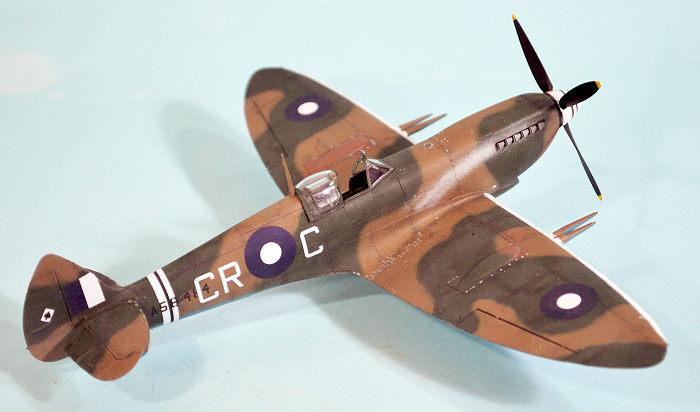 Given the range limitations of the
Spitfire, it was not really suited to the needs of the theater, and General
George Kenney, USAAF, who commanded the Allied air forces in the SWPA, did
not favor its presence. However, he also refused RAAF requests to equip with
the P-51 Mustang. The RAAF was left with no alternative but to update the
Spitfire force, and this began when the RAAF received 251 F.VIIIs, serials
A58-300 to 550, from November 1943 through July 1944.
Given the range limitations of the
Spitfire, it was not really suited to the needs of the theater, and General
George Kenney, USAAF, who commanded the Allied air forces in the SWPA, did
not favor its presence. However, he also refused RAAF requests to equip with
the P-51 Mustang. The RAAF was left with no alternative but to update the
Spitfire force, and this began when the RAAF received 251 F.VIIIs, serials
A58-300 to 550, from November 1943 through July 1944.
Clive "Killer" Caldwell was the leading Australian fighter ace in the Western Desert. As such, when the Australian squadrons were recalled for the defense of the homeland, he returned and took command of the Darwin wing. Flying the Spitfire Vc, he scored seven victories over the Japanese. When 80 Wing re-equipped with the Spitfire VIII in 1944, Caldwell moved up to 80 Wing Commander, while fellow ace Robert Gibbes became the Wing Leader (flying). The position of Wing Commander is primarily administrative, and did not involve regularly flying on operations, though Caldwell did his best to keep his hand in.
His first Spitfire VIII is the more famous of the two, and almost all information that has been recorded about it previously is incorrect. A58-484, the Spitfire VIII Caldwell flew, was maintained by 457 Sqn from July 1944 and then 452 from Nov 1944. 80 Wing became specialists in ground attack, and this led to Caldwell’s Spitfire VIII being modified to carry the full designed armament of four 20mm cannon, with the .303 machine guns removed.
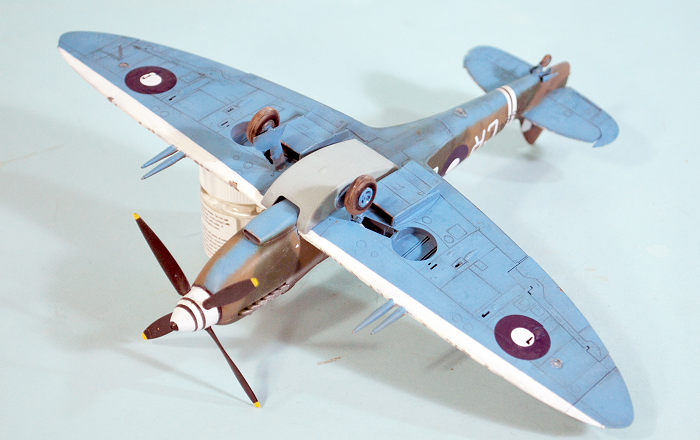 Modelers have long been interested
in these Australian Spitfires, and have had to put up with a lot of
misleading information regarding the camouflage and markings. Fortunately
there is now a body of recent research available, which goes far toward
solving the problem. I am indebted to RAAF historical researcher Peter
Malone for providing the following information.
Modelers have long been interested
in these Australian Spitfires, and have had to put up with a lot of
misleading information regarding the camouflage and markings. Fortunately
there is now a body of recent research available, which goes far toward
solving the problem. I am indebted to RAAF historical researcher Peter
Malone for providing the following information.
The first shipment of Spitfire VIIIs arrived in Australia in desert camouflage. Repainting was done initially at the Aircraft Depots, but later aircraft seem to have been issued to the squadrons still in RAF desert camouflage and were repainted at unit level.
Many of the Spitfires retained the RAF Dark Earth and Azure Blue, with the Middle Stone over-painted with RAAF Foliage Green. Close examination of photos often reveals over-spray from the Foliage Green on the Azure Blue. On these aircraft the upper/lower color demarcation line followed that of the original pattern. There seem to have been three basic styles, which closely follow the patterns which can be seen on desert finished Spitfire VIIIs in the Middle East and Italy.
| THE KIT |
Eduard’s Spitfire VIII has been around since 2015. The kit features type-specific wings with the reduced-span ailerons and the wing leading edge tanks that were unique to this mark. Additionally, the fuselage has the retractable tail wheel. As with all the other releases, the ailerons, elevators and rudder are separate and can be posed dynamically. The Profipack release includes a photo-etch fret with the instrument panel, seatbelts, and radiators. The kit comes with decals for six aircraft from Italy, India and Australia.
| CONSTRUCTION |
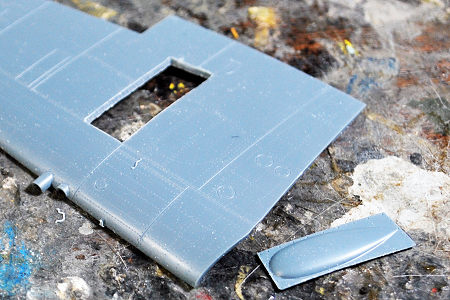 This project came about as a
result of the release of Eduard’s “Eagles’ Call” Limited Issue kit, which
provides two kits, a Spitfire Vb and Spitfire Vc. The wing for the Vc
includes separate cannon breech fairings, and interestingly enough, there
are two sets included.
This project came about as a
result of the release of Eduard’s “Eagles’ Call” Limited Issue kit, which
provides two kits, a Spitfire Vb and Spitfire Vc. The wing for the Vc
includes separate cannon breech fairings, and interestingly enough, there
are two sets included.
I have long wanted to do Caldwell’s Spitfire with the distinctive 4 cannon development. However, doing so required possession of the early large teardrop cannon breech fairing. When I realized the new Eagles Call kit had that part separate, and included the four 20mm cannon barrel fairings, I immediately thought of finding a way to do this modification.
The big problem is that the wing of the Mk. VIII kit has the cannon fairing integral to the upper wing surface. I first cut out that fairing, leaving a “margin” of about 1/16 inch from the molded panel line border for that panel. I then cleaned out the opening and filed the edges angling up to the panel line border, so that the surface was at about a 45-degree angle. I then filed down the interior of the cannon fairing part, test-fitting it to the opening until I got a perfect fit. With the hole angled as it is, there is no chance of ever pushing the separate cannon fairing part into the wing. I took the cannon fairings from the Spitfire Vc kit.
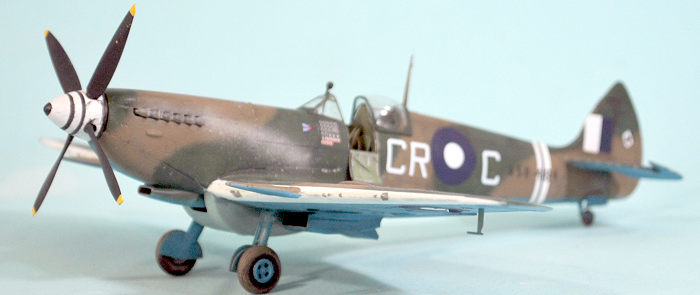 Other than that, the kit was
assembled in the normal way: insure all sprue nubs are cleaned off and that
all mating surfaces are nice and smooth. I also assembled the wing to the
fuselage in my new way: assemble the wheel well detail in the lower wing
part, then attach the lower wing to the assembled fuselage, then attach each
upper wing part. One is assured of perfect fit this way, with no “industrial
strength pushing and shoving” to mate the wing sub-assembly to the fuselage
sub-assembly, which is the only difficult part of the kit assembly process
if you do it the way the instructions call for, with complete assembly of
the wing.
Other than that, the kit was
assembled in the normal way: insure all sprue nubs are cleaned off and that
all mating surfaces are nice and smooth. I also assembled the wing to the
fuselage in my new way: assemble the wheel well detail in the lower wing
part, then attach the lower wing to the assembled fuselage, then attach each
upper wing part. One is assured of perfect fit this way, with no “industrial
strength pushing and shoving” to mate the wing sub-assembly to the fuselage
sub-assembly, which is the only difficult part of the kit assembly process
if you do it the way the instructions call for, with complete assembly of
the wing.
I used the 108 gallon belly tank from the Spitfire Vc kit.
| COLORS & MARKINGS |
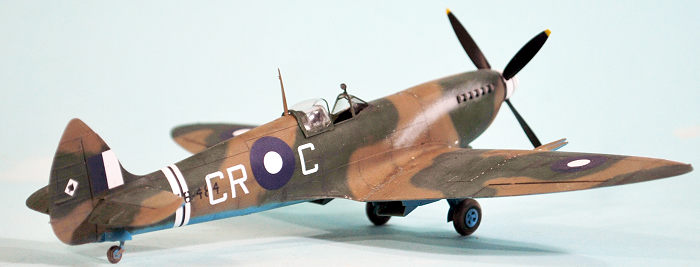 I painted the model Azure Blue on
the lower surfaces, with the upper surfaces done with RAF Dark Earth and
RAAF Foliage Green, using my Tamiya mixtures for the three colors and
applying them freehand with my Passche-H airbrush. I
carefully masked the spinner to paint the two black stripes. The drop tank
was painted RAAF Sky Blue before being attached after the model was painted.
I painted the model Azure Blue on
the lower surfaces, with the upper surfaces done with RAF Dark Earth and
RAAF Foliage Green, using my Tamiya mixtures for the three colors and
applying them freehand with my Passche-H airbrush. I
carefully masked the spinner to paint the two black stripes. The drop tank
was painted RAAF Sky Blue before being attached after the model was painted.
I used the set of Clive Caldwall decals from the Victory Productions “Spitfire: Aces of the Empire” sheet.
I lightly “dinged” the model, keeping in mind this was the group commander’s airplane and it would thus have been very well-maintained. I applied some grey exhaust staining as seen in photos. I then unmasked the cockpit glass and installed the canopy in the open position.
| CONCLUSIONS |
With the amount of extra parts one gets with Eduard kits, there are many opportunities to do conversions like this. I’ve now done a “bucket list” model, and am quite happy with the result. As has been said before, Eduard’s Spitfires, now released in many different sub-types, are the best, most accurate Spitfire kits in 1/48. I’m sure I’ll do many more. A man can’t have too many Spitfires.
2
8 October 2021Copyright ModelingMadness.com. All rights reserved. No reproduction in part or in whole without express permission
Review kit courtesy of my wallet
If you would like your product reviewed fairly and fairly quickly, please
contact the editor or see other details in the
Note to
Contributors.